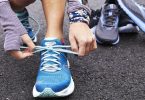Running is a sport accessible to all, and starting to run is relatively simple at any age. Running is one of the best sports for improving your health and fitness & losing weight.
In this article, find 7 essential tips for beginner runners who want to start running easily and love it.
Before running, check with your doctor to ensure your condition allows you to run safely. Running is a traumatic sport and can cause joint pain or injury, especially if you’ve been sedentary or have other health concerns.
Tip 1: Set a goal
The best way to get motivated to start running is to set a goal. Some of the goals that can keep you motivated include:
- Train for a race, like a 5 or 10 km to start.
- Lose weight.
- Be able to run 10 km in less than 1 hour.
- Run 2-3 times weekly, every week, for 6 months.
- Stop smoking.
It’s up to you to find the goal that suits you and makes you want to put on your shoes and train. Then, set a training routine, blocking out specific slots in your schedule to ensure you have time to run.
Tip 2: Warm up well
Before running, it is recommended to do a good warm-up. Indeed, because running is a traumatic sport, warming up well before your session will allow you to feel better and limit the risk of pain and injury.
A good warm-up session should consist of 3 parts:
- Joint heating.
- Muscle warm-up.
- Gradual cardio-respiratory warm-up.
10 to 15 minutes of warming up is recommended before your workout.
Tip 3: Alternate walking and running
To start running easily, it is advisable to alternate brisk walking with running. This allows you to start gently, limit the risk of injury, be less out of breath, and train more efficiently.
Start with short sessions of 20 to 30 minutes, alternating brisk walking and jogging. For example, after a good warm-up, run 1 minute, walk for 1 minute, and repeat 10 times.
Then, you can gradually increase the running time then decrease the walking time during your sessions. With this method, the goal is to be able to run comfortably for 20 minutes without stopping in 4 to 6 weeks.
In the beginning, don’t set yourself the goal of covering so many miles in a certain amount of time. You risk running too fast and being very out of breath. You risk injuring yourself and no longer want to run. The average speed of your workouts is not essential if you are a beginner.
Wait to start with intense exercises. Your body must develop its endurance capacities; your muscles must be strengthened, as well as your joints. During your training, you must be able to speak and articulate 2 to 3 sentences without being out of breath.
Here is an example of a training plan to start running.
Tip 4: Define a training plan
To start running, you must define a training plan. Indeed, it is recommended to run only some days when you start. This can increase your risk of injury, and you risk accumulating fatigue and not recovering.
So, to start, plan 2 to 3 running training sessions per week maximum. On other days, take the opportunity to do brisk walking, cycling, or swimming, which are less traumatic sports.
In addition, include 1 to 2 muscle-building sessions in your plan. In addition to being effective for better running and less injury, muscle building is also essential for health and weight loss.
Here is an example of a training plan to start running.
Beginner running program (8 weeks):
Tip 5: Choose the right running shoes
To start running, there is no need to ruin yourself by buying the latest expensive model of shoes.
Here are some tips for choosing a suitable model of running shoes:
-
- Prioritize comfort. You should feel good in your shoe. Check that no hyper pressure zone could cause overheating and blisters.
- Choose a universal model. Corrections in pronation or supination disturb the excellent mobility of your foot. If you need it, you must make an appointment with a podiatrist.
- Avoid maximalist or minimalist models, with too much drop and cushioning or none. These models are not recommended for beginners.
- Choose a flexible model to give your feet maximum freedom. The front of your foot should not be too tight and should be able to spread out over the sole without being compressed.
Tip 6: Don’t neglect your recovery
The goal of recovery is to allow your body to repair damaged tissues, restore your energy reserves during exercise, and thus make progress as you train. With a good recovery, you can progress and achieve your goals.
In the running, optimal recovery requires food and hydration after exercise and quality sleep each night. Then, specific techniques can help to recover better, such as massage, cold bath, or compression garments.
If you are too sore, do not go back to running. Aches are muscle micro-lesions. Forcing it can lead you quickly to injury.
It is, therefore essential not to run every day at the start. If you’re impatient, go for a brisk walk, bike ride, swim, or strength training.
Tip 7: Eat before and after your workout
To start running, good nutrition is essential. It gives you quality energy. It will allow you to recover and, therefore to progress properly.
Your diet should provide you with enough energy to repair the damage done to your body during your running session. Even if you want to lose weight by running, you must eat a healthy and balanced diet.
Before and after your training, you can eat a meal adapted to running, ideal for athletes, and composed of:
- 1/3 carbohydrate-rich foods (quinoa, rice, oats, buckwheat, sweet potato, potato, pasta).
- 1/3 protein-rich foods (meat, fish, eggs, legumes, tofu).
- 1/3 cooked or raw vegetables (spinach, broccoli, kale, arugula, carrots, tomatoes, zucchini, peppers).
- Good fats (olive oil, avocado, oilseeds).
By maintaining this balance, you can provide your body with enough vitamins and minerals to avoid the primary deficiencies in athletes.
Also, remember to eat well before and after your workout.








Leave a Comment